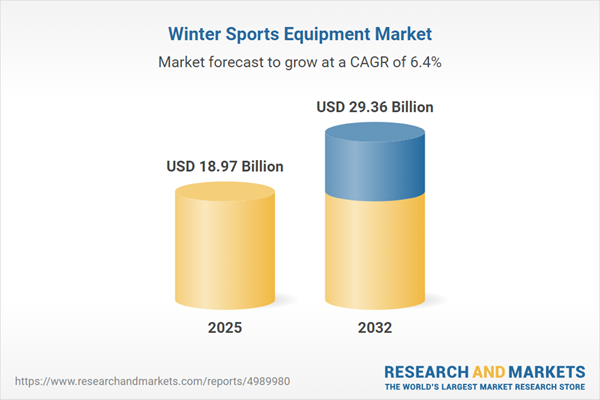Speak directly to the analyst to clarify any post sales queries you may have.
The winter sports equipment market is experiencing dynamic transformation, shaped by technological advancements, sustainability imperatives, and evolving consumer demands. Senior decision-makers require clear guidance to navigate these shifts and refine their competitive strategies within a fast-moving global landscape.
Market Snapshot: Winter Sports Equipment Market
The winter sports equipment market grew from USD 17.81 billion in 2024 to USD 18.97 billion in 2025. It is set to expand at a CAGR of 6.44%, with projections indicating the market will reach USD 29.36 billion by 2032. This trajectory highlights robust stakeholder confidence, strong end-user participation, and expanding investment in product innovation and distribution capabilities.
Scope & Segmentation
This comprehensive analysis delivers actionable insights across essential product categories, target demographics, sales channels, and geographic regions relevant to the winter sports equipment market.
- Equipment Types: Apparel (gloves, hats, jackets, pants), bindings (ski, snowboard), boots (ski, snowboard), poles (ski), protective gear (goggles, helmets, pads), skis (alpine, cross country, freestyle), and snowboards (all mountain, freeride, freestyle).
- Gender Preferences: Men, unisex, and women’s product lines, each with distinctive design, fit, and ergonomic attributes.
- Distribution Channels: Direct sales, online retail, specialty stores, and sporting goods outlets.
- End User Types: Professional athletes and recreational participants, shaping unique expectations for performance and comfort.
- Regional Markets: Americas (North America: United States, Canada, Mexico; Latin America: Brazil, Argentina, Chile, Colombia, Peru), Europe, Middle East & Africa (including key markets such as United Kingdom, Germany, France, Switzerland, UAE, Saudi Arabia, South Africa), and Asia-Pacific (China, India, Japan, Australia, South Korea, and more).
- Leading Companies: Amer Sports Oyj, HEAD NV, Rossignol SAS, Tecnica Group SpA, K2 Sports LLC, Burton Snowboards Inc., Fischer Sports GmbH, Völkl International GmbH, Elan d.o.o., Marker International GmbH.
- Technology Trends: Integration of advanced composites, bio-based materials, digital monitoring systems, virtual/augmented reality training, and closed-loop production models.
Key Takeaways for Winter Sports Equipment Executives
- Demand for products integrating both high performance and digital sophistication is redefining consumer expectations and supporting a premiumization trend.
- Sustainability remains a central market driver, compelling industry leaders to accelerate adoption of eco-conscious materials and closed-loop manufacturing systems.
- The rise of modular, customizable equipment reflects increasing consumer desire for personalization and enhanced fit, influencing product roadmaps and manufacturing strategies.
- Growth in direct-to-consumer and experiential retail channels is enabling stronger brand storytelling and data-driven engagement with digitally native end users.
- Collaboration with influencers and professional athletes is amplifying demand for unique product lines and supporting brand differentiation.
- Regional dynamics require flexible go-to-market strategies, as participation rates and infrastructure investment vary significantly between mature and emerging markets.
Tariff Impact in the Winter Sports Equipment Market
Recent U.S. tariffs have placed upward pressure on raw material costs, particularly for steel and specialty polymers. This shift has led firms to reevaluate supplier relationships, drive procurement negotiations, and invest in localized production for critical components. Industry leaders are also forming alliances to invest in manufacturing technology, building greater resilience against fiscal volatility while maintaining strict performance standards.
Methodology & Data Sources
This report uses a multi-phase research approach. It synthesizes public filings, technical journals, and patent analysis with direct interviews from senior executives, scientists, buyers, and logistics professionals. Field observations and structured surveys with athletes and recreational users further enrich the findings. Rigorous cross-validation through frameworks such as SWOT analysis ensures comprehensive and reliable insights.
Why This Report Matters
- Enables decision-makers to benchmark their product, technology, and supply strategies against market leaders and innovation front-runners.
- Supports proactive risk mitigation by mapping supply chain vulnerabilities, regulatory pressures, and fast-evolving consumer trends worldwide.
- Empowers organizations to prioritize investments in customization, sustainability, and digital transformation for scalable, sustainable growth.
Conclusion
Leaders in the winter sports equipment sector must anticipate shifting market conditions and evolving consumer expectations. Informed decisions, enabled by deep market intelligence, will drive long-term competitiveness and support sustainable expansion in a rapidly changing global environment.
Additional Product Information:
- Purchase of this report includes 1 year online access with quarterly updates.
- This report can be updated on request. Please contact our Customer Experience team using the Ask a Question widget on our website.
Table of Contents
3. Executive Summary
4. Market Overview
7. Cumulative Impact of Artificial Intelligence 2025
Companies Mentioned
The companies profiled in this Winter Sports Equipment market report include:- Amer Sports Oyj
- HEAD NV
- Rossignol SAS
- Tecnica Group SpA
- K2 Sports LLC
- Burton Snowboards Inc.
- Fischer Sports GmbH
- Völkl International GmbH
- Elan d.o.o.
- Marker International GmbH
Table Information
| Report Attribute | Details |
|---|---|
| No. of Pages | 194 |
| Published | November 2025 |
| Forecast Period | 2025 - 2032 |
| Estimated Market Value ( USD | $ 18.97 Billion |
| Forecasted Market Value ( USD | $ 29.36 Billion |
| Compound Annual Growth Rate | 6.4% |
| Regions Covered | Global |
| No. of Companies Mentioned | 11 |









